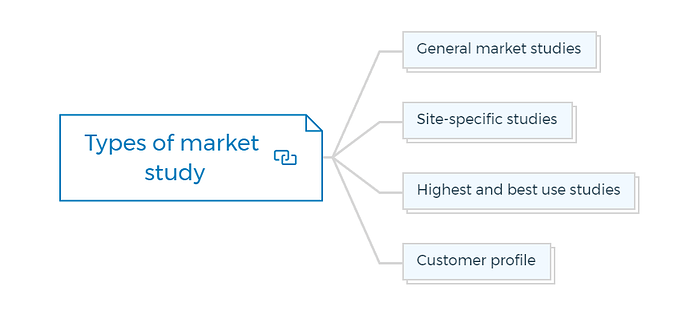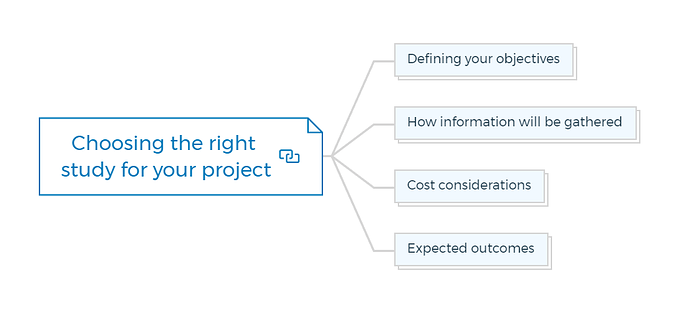1. Types of market study
Market studies come in different shapes and sizes, depending on the size and complexity of your property development project. You may only need to answer a few questions for smaller and familiar projects. In contrast, larger, long-term projects aimed at multiple target markets involve numerous and intricate inquiries.
Here are some key goals of market studies in simpler terms:
- Understanding Supply and Demand
- Identifying the Right Market and Property Type
- Profiling the Buyer’s Lifestyle
- Gaining Specialized Market Knowledge
- Supporting Financing and Investment
- Demonstrating Demand to Authorities
1.1. General market studies
These studies cover large geographical areas, like states or counties, to find the right location for a specific type of development. Typically, big development companies with experience in similar projects conduct these studies.
They look at buyer demographics, economic conditions, and developments like new employers, schools, or recreational centres. General studies also explore the nature of the local marketplace, competition, and economic factors affecting homebuyers.
1.2. Site-specific studies
If you already have a piece of land or an option to buy one, a site-specific study focuses on that specific location. It evaluates the land’s size, potential for housing units, and overall density. It also considers natural features such as mountains or waterfronts and regulatory requirements. This information helps you decide what type of development suits that site and which buyers to target.
1.3. Highest and best use studies
You need this study when you own land or an existing property needing redevelopment. It determines the most profitable use of the land while adhering to regulations. Like a site-specific study, it helps you choose what to develop and who your target market should be.
However, it also includes a financial analysis to ensure your project makes sense financially.
1.4. Customer profile
Dive deep into the specific needs and desires of your target customers. Consider factors such as their preferences for design, amenities, and any unique features they may seek in their ideal homes.
2. Choosing the right study for your project
No matter what kind of study you plan, it begins with a clear understanding of your goals. You should collaborate with your marketing team to determine the best study type for your specific needs. Here are some key things to consider:
2.1. Defining your objectives
Start by determining what you want to achieve through the study. What kind of information are you looking to gather, and what do you intend to do with that information?
2.2. How information will be gathered
Decide on the methods you’ll use to collect the data. Will it involve surveys, interviews, data analysis, or a combination?
2.3. Cost considerations
Assess the costs associated with each approach to ensure it aligns with your budget.
2.4. Expected outcomes
Clarify what you can reasonably expect to gain from the study. What insights or findings are you hoping to uncover?
Every type of market study has its unique set of questions to answer. Typically, marketing studies are conducted right at the project’s start, even before you select a site or purchase one. However, there are exceptions.
You are missing out if you haven’t yet subscribed to our YouTube channel.
3. Housing supply and demand
3.1. Assess current supply
Analyze the current housing supply in the market. This involves looking at the number of available units, their types (e.g., apartments, single-family homes), and their conditions.
3.2. Evaluate demand
Understand the demand for housing, considering factors like population growth, migration trends, and changing demographics. Predict future demand based on economic and social factors.
4. Sources of demographic data
4.1. Census data
- Utilize official government census data for comprehensive demographic information. This includes population size, age distribution, income levels, and household composition.
4.2. Other sources of demographic data
- Seek data from market research firms that specialize in real estate analysis.
- Tap into local real estate associations for market insights and reports.
- Utilize online databases and platforms that provide demographic data specific to your project’s location.
Learn More
5. Capture ratio
- Calculate the capture ratio to estimate how much of the market your project is likely to capture. This involves comparing your project’s potential sales or leasing volume to the overall market demand.
6. Understanding the target market
- Develop a comprehensive understanding of your target market’s needs and preferences. Conduct surveys, focus groups, or interviews to gain insights into what potential buyers or tenants are looking for in a property.
7. Project viability
- Assess the feasibility and profitability of your development project. Consider factors such as:
- Construction costs and timeline.
- Financing options and interest rates.
- Expected returns on investment.
- Potential risks and mitigation strategies.
8. Purchase market information
8.1. In-house market studies
- If your organization has the expertise, conduct internal market research. This can involve using existing data, leveraging in-house analysts, or conducting surveys among your stakeholders.
8.2. Professional market studies
- Consider hiring external experts or consultants with specific knowledge of the local real estate market. They can provide in-depth analysis and unbiased insights.








